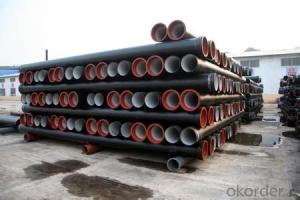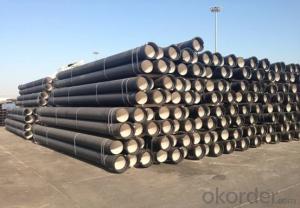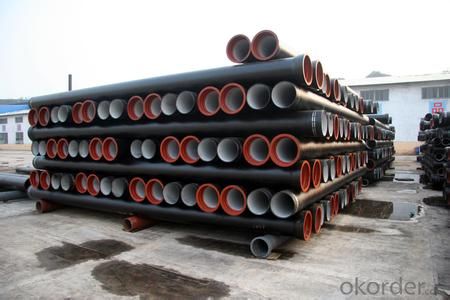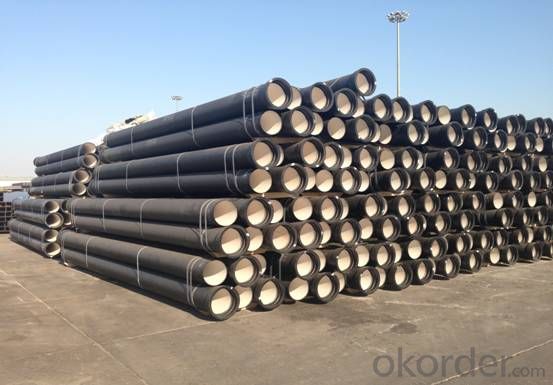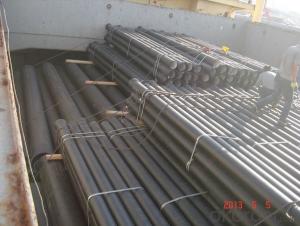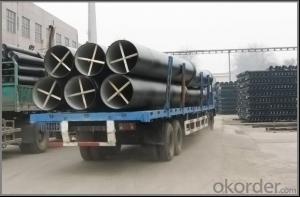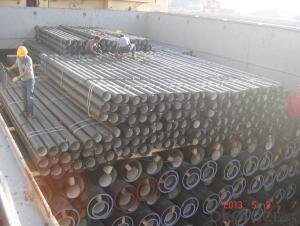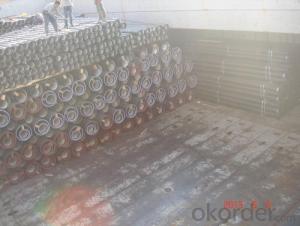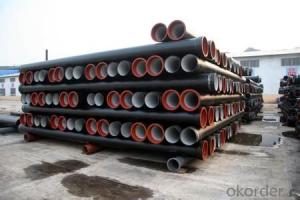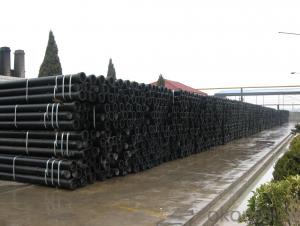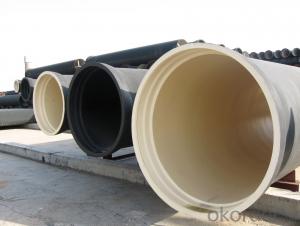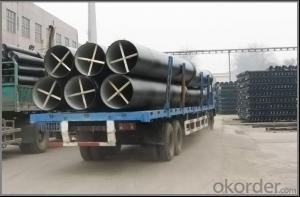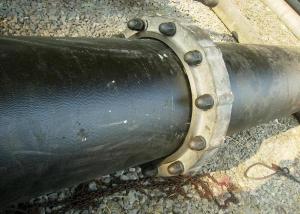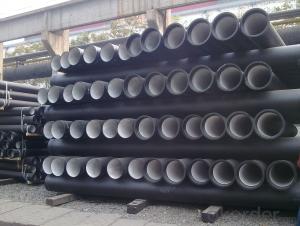DUCTILE IRON PIPE C DN125
- Loading Port:
- China Main Port
- Payment Terms:
- TT OR LC
- Min Order Qty:
- -
- Supply Capability:
- -
OKorder Service Pledge
OKorder Financial Service
You Might Also Like
Ductile Iron Cast Pipe is without any defects compare with tradition casting tech, which has many advantages particularly as follow:
(1) High density. In the "vertical upward casting" process, the melt iron of centre liquid column in center crystallizer is continuously feeding for volume shrinkage caused by condensation tube at outer circumference , which lead to be free of shrinkage porosity.
(2) High purity. When melt iron pouring, the mixed impurities such as gas, dross, sand grain which are lighter than melt iron could be eliminated at furnace mouth, its impossible to enter into the crystallizer through the channel, so the melt iron into the crystallizer is very pure.
(3) Strength with toughness. The cooling speed provided by continuous crystallizer is 30 times than sand casting and 5 times than centrifugal casting, and doesn't produce white iron, the eutectic cell volume of continuous cast iron is one eighth to one tenth compare with traditional cast iron. The density of graphite nodule in ductile iron can reach 300-700 pcs/mm2. Therefore, all reason above improve the strength and toughness of continuous cast iron.
(4) Free machining. The high speed cooling make the hardening phase (such as boride, steadite) not appear like reticular, massive or thick, but diffuse like fish bone and pane in shape, moreover, there are tiny graphite flakes inlaid hardening phase. It's free machining in BrinellHardness the range of 250-300HB. However, the Brinell Hardness of 250 is top limit to common metal materials.
(5) Uniform composition of tube wall. The convection mixing of liquid column caused by marching type drawing in crystallizer make the composition of tube wall well-distributed, and concentration gradient very little.
(6) High productivity. To the wall thickness of tube under 10mm, the speed of continuous casting is 1 meter/min, to the wall thickness of tube under 20mm, the speed of continuous casting is 0.5 meter/min, which is high efficiency that centrifugal or other casting tech couldn't reach.
- Q: Can ductile iron pipes be used for underground steam distribution systems?
- Yes, ductile iron pipes can be used for underground steam distribution systems. Ductile iron is a type of cast iron that has been treated with magnesium to make it more flexible and resistant to cracking. This makes it suitable for use in underground applications where the pipes may need to withstand high pressure and temperature conditions, such as in steam distribution systems. Ductile iron pipes have excellent strength and durability, which makes them capable of handling the extreme conditions associated with steam distribution. Additionally, their corrosion resistance properties make them a reliable choice for long-term use in underground environments. However, it is important to note that proper insulation should be used to prevent heat loss and ensure the efficiency of the steam distribution system.
- Q: It's not easy to drill ductile iron with cobalt high speed steel bit. Please help to point it out
- Choose carbide or whole carbide drill, about 90HRC in hardness. But it requires a high number of drills, around 3000.
- Q: What are the different joint restraint systems available for ductile iron pipe?
- Some of the different joint restraint systems available for ductile iron pipe include mechanical joint restraints, push-on joint restraints, and restrained joint systems.
- Q: Are ductile iron pipes suitable for fire protection systems?
- Yes, ductile iron pipes are suitable for fire protection systems. Ductile iron is known for its strength, durability, and ability to withstand high pressure and heat, making it an ideal choice for fire protection systems. Additionally, ductile iron pipes have excellent corrosion resistance, which is crucial for ensuring the longevity and reliability of fire protection systems.
- Q: How do ductile iron pipes handle water velocity?
- Ductile iron pipes are well-suited to handle water velocity due to their unique mechanical properties. Ductile iron is a highly durable and strong material that can withstand high water velocities without experiencing significant damage or deformation. The pipe's inherent ductility allows it to absorb the energy created by the flowing water, which helps to minimize the risk of pipe failure or bursting. This property makes ductile iron pipes capable of handling high-pressure water flow, making them ideal for applications where water velocity is a concern. Additionally, ductile iron pipes have a smooth internal surface, which promotes efficient water flow and minimizes friction losses. This smoothness reduces the resistance encountered by the water as it flows through the pipe, allowing for higher water velocities without compromising the pipe's integrity. Furthermore, ductile iron pipes can be manufactured in various sizes and thicknesses, allowing for customization based on specific water velocity requirements. This flexibility ensures that ductile iron pipes can effectively handle a wide range of water velocities, from low-flow applications to high-velocity scenarios. In summary, ductile iron pipes have excellent handling capabilities when it comes to water velocity. Their strength, ductility, and smooth internal surface contribute to their ability to withstand high water velocities without compromising their structural integrity, making them a reliable choice for water distribution systems.
- Q: Are ductile iron pipes suitable for use in industrial applications?
- Ductile iron pipes possess the necessary qualities to be used in industrial settings. They are renowned for their robustness and durability, which renders them perfect for handling the rigorous demands of industrial environments. Moreover, these pipes are resistant to corrosion and can endure high pressures and temperatures. Additionally, they exhibit exceptional resistance to impact, thus making them appropriate for areas with heavy traffic or potential mechanical damage. Furthermore, their flexibility allows them to absorb vibrations and shocks, thereby further enhancing their suitability for industrial usage. Consequently, ductile iron pipes are a dependable and cost-efficient option for various industrial sectors, including water and wastewater treatment, mining, power generation, and chemical plants.
- Q: What is the expected thermal expansion of ductile iron pipes?
- The expected thermal expansion of ductile iron pipes is typically around 0.006 inches per inch per degree Fahrenheit.
- Q: The difference between spheroidal graphite cast iron pipe and HDPE water supply pipe
- HDPE pipe is made of hot melt butt joint, and the strength of interface is very good. Ductile iron pipes are made of socket joint, and reinforced concrete piers shall be rammed on three links, elbows and other parts. In this regard, the cost of natural selection of ductile iron pipe, HDPE pipe than the choice of high.
- Q: How are ductile iron pipes tested for quality assurance?
- Ductile iron pipes are tested for quality assurance through various methods such as hydrostatic testing, visual inspection, and mechanical testing. Hydrostatic testing involves subjecting the pipes to high-pressure water to check for any leaks or weaknesses. Visual inspection is carried out to identify any surface defects or irregularities that may affect the quality of the pipe. Mechanical testing includes conducting tensile strength tests, elongation tests, and hardness tests to ensure that the pipes meet the required standards and can withstand the intended application. These testing procedures help ensure the quality and reliability of ductile iron pipes.
- Q: How many casting methods are there in ductile iron casting? A 60*6 discus can not have sand holes. Its surface is smooth. What process can be used to make it?
- The metal mould is ok! The surface quality of the casting is better than that of the sand mold. But later heat treatment is needed.
Send your message to us
DUCTILE IRON PIPE C DN125
- Loading Port:
- China Main Port
- Payment Terms:
- TT OR LC
- Min Order Qty:
- -
- Supply Capability:
- -
OKorder Service Pledge
OKorder Financial Service
Similar products
Hot products
Hot Searches
Related keywords
